How Do I Choose the Right Size of Butterfly Design Sunglasses for My Face?
Finding the perfect pair of butterfly design sunglasses is more than just a fashion statement—it's about complementing your unique facial features. These iconic eyewear pieces, characterized by their distinctive upswept frames that resemble butterfly wings, have remained a timeless accessory since their popularization in the 1950s. However, choosing the right size can be challenging due to the distinctive shape and bold nature of butterfly frames. This guide will help you navigate the process of selecting butterfly design sunglasses that not only look stylish but also fit your face perfectly.
What face shapes look best with butterfly design sunglasses?
Complementary Facial Structures for Butterfly Frames
Butterfly design sunglasses are particularly flattering for certain face shapes due to their distinctive upswept corners and wider lens area. Square and heart-shaped faces often benefit most from these frames. The soft, curved edges of butterfly design sunglasses can beautifully balance the angular jawline of square faces, creating a harmonious contrast. For heart-shaped faces, the wider top and narrower bottom of butterfly sunglasses mirror the natural facial contours, enhancing your features rather than competing with them. Oval faces also work wonderfully with butterfly frames as this versatile face shape can support various styles, including the dramatic flair of butterfly design sunglasses. The key is finding proportions that complement rather than overwhelm your natural features.
Sizing Considerations for Different Facial Proportions
When selecting butterfly design sunglasses, size matters significantly in relation to your facial proportions. For petite faces, oversized butterfly frames can overwhelm your features, so opt for medium-sized frames that maintain the distinctive butterfly shape without dominating your face. Conversely, if you have a larger face, don't shy away from more dramatic butterfly design sunglasses with wider frames that balance your proportions. Pay particular attention to the width of the frames in relation to your face—ideally, butterfly sunglasses should be slightly wider than the broadest part of your face, creating that perfect proportional balance. Additionally, consider the height of the frames; butterfly design sunglasses should ideally extend from your eyebrows to the middle of your cheeks for that classic look.

Color Selection to Enhance Your Features
The color of your butterfly design sunglasses can dramatically influence how they complement your face. For those with warm skin tones (golden, peachy, or yellow undertones), tortoiseshell, brown, golden, honey, or amber butterfly design sunglasses will enhance your natural glow. If you have cool skin tones (pink, red, or bluish undertones), consider black, silver, blue, gray, or purple frames. For those with neutral undertones, you're fortunate to have flexibility with most colors. Beyond skin tone, consider how frame color interacts with your hair and eye color—contrasting colors can create a striking look, while complementary colors offer subtle elegance. Bold-colored butterfly design sunglasses can serve as a statement piece, while neutral colors provide versatility across various outfits and occasions.
How do I measure for the correct butterfly design sunglasses size?
Understanding Frame Measurements
When shopping for butterfly design sunglasses, understanding the technical measurements printed on most quality frames is essential. These typically include three key numbers: lens width, bridge width, and temple length. For butterfly design sunglasses, the lens width usually ranges from 50-62mm, though this can vary by style and brand. The distinctive butterfly shape typically requires careful attention to lens height as well, which often isn't listed but is crucial for this style. The bridge width (the portion that crosses over your nose) generally ranges from 14-24mm and should fit comfortably without pinching or sliding. Temple length, measuring from 135-150mm, determines how the sunglasses arms extend over your ears. For butterfly design sunglasses specifically, pay extra attention to the lens height and how the frames sit on your cheekbones, as the upswept shape can sometimes interfere with your cheeks when smiling or talking.
DIY Measurement Techniques
If you're shopping online or don't have access to professional fitting services, you can easily measure for butterfly design sunglasses at home. Start by measuring your current comfortable sunglasses as a baseline. Using a millimeter ruler, measure the widest part of each lens, the bridge, and the temple length. For butterfly design sunglasses specifically, also measure the height of the lens from top to bottom at its tallest point. If you don't have existing glasses to measure, use a credit card (standardized at 85.60mm × 53.98mm) as a reference to estimate face width. Another DIY technique involves drawing the outline of your face on a mirror with a washable marker while standing at a fixed distance, then measuring the dimensions. For butterfly design sunglasses, measure from your eyebrows to the middle of your cheeks to determine ideal lens height. Remember that butterfly frames should follow the natural arch of your eyebrows while providing adequate coverage without touching your cheeks.
Professional Fitting Considerations
While DIY measurements provide a good starting point, professional fitting can make all the difference with distinctive styles like butterfly design sunglasses. Optical professionals can assess how these frames sit on your face's unique contours, particularly important given the upswept corners characteristic of butterfly styles. During a professional fitting, pay attention to how the butterfly design sunglasses distribute weight across your nose and ears—comfort is crucial for sunglasses you'll wear for extended periods. The frames should rest securely without leaving pressure marks or sliding down. Professional fitters can also recommend adjustments specific to butterfly frames, such as nose pad customization or temple arm curvature modifications. Many optical shops offer complimentary adjustments even after purchase, ensuring your butterfly design sunglasses continue to fit perfectly as frames naturally shift with use. If possible, try wearing potential butterfly sunglasses for at least 10-15 minutes in-store to assess comfort accurately.
Can butterfly design sunglasses be adjusted to fit my face better?
Frame Adjustment Techniques
Butterfly design sunglasses, like most eyewear, can be adjusted for a more customized fit. For plastic frames, which are common with butterfly styles, gentle heat can make the material pliable enough for adjustments. Professional opticians typically use specialized heating tools, but at home, you can carefully run the frame under warm (not hot) water for 30-60 seconds to soften the material. Once warmed, you can gently bend the temple arms to better contour to your ears or slightly adjust the frame front to better follow your facial curves. Metal butterfly design sunglasses offer more adjustment options through their nose pads and screws. Small screwdrivers can tighten loose temple hinges, while nose pads can be carefully bent inward for a more secure fit or outward to relieve pressure. Remember that butterfly design sunglasses require particular attention to the upper outer corners, as their distinctive upswept shape sometimes needs fine-tuning to avoid contact with your eyebrows or creating unwanted shadows.
Common Fit Problems and Solutions
Several fit issues frequently arise with butterfly design sunglasses due to their distinctive shape. If your sunglasses slide down your nose, consider adjusting the nose pads to create more friction or having the temple arms slightly curved to better grip behind your ears. Conversely, if the frames leave red marks or feel too tight, gentle outward adjustments to the temple arms or bridge can provide relief. Another common problem with butterfly design sunglasses is cheek contact—when smiling or talking, the lower portion of the frames may touch your cheeks. This can often be resolved by having the frames sit slightly higher on your nose through nose pad adjustments. Uneven sunglasses (where one side sits higher than the other) typically indicate asymmetrical ears or previous frame warping and can usually be corrected by professional alignment. For prescription butterfly design sunglasses, proper pantoscopic tilt (the vertical angle of the lenses relative to your face) is especially important due to the larger lens area and can be adjusted by a professional.
When to Seek Professional Adjustments
While minor adjustments can be performed at home, certain circumstances warrant professional assistance with your butterfly design sunglasses. If your frames are made from high-end materials like acetate, titanium, or feature specialized hinges, professional adjustment prevents potential damage. Most optical shops offer complimentary adjustment services, even for sunglasses purchased elsewhere. Professional opticians have specialized tools like frame warmers, optical pliers, and ultrasonic cleaners that ensure precise modifications without risking damage. They're particularly valuable for butterfly design sunglasses, as the distinctive shape requires careful handling to maintain the signature upswept corners while achieving proper fit. Consider professional help if you experience persistent discomfort, notice the lenses creating visual distortion, or need prescription lenses optimally positioned. For vintage or collectible butterfly design sunglasses, always seek professional adjustment, as these frames may contain materials that require specialized knowledge to safely modify. Remember that multiple small adjustments are often better than one dramatic change, so regular professional tune-ups can extend the life and comfort of your butterfly sunglasses.
Conclusion
Finding the perfect butterfly design sunglasses involves understanding your face shape, proper measurements, and potential adjustments for optimal fit. These iconic frames can beautifully enhance your features when sized correctly. Remember to consider face shape compatibility, frame measurements, and professional fitting when needed. With the right approach, you'll find butterfly sunglasses that not only look stylish but feel comfortable for everyday wear. Wenzhou GuangMing Glasses Co., Ltd. offers a unique blend of manufacturing and trade in the glasses industry. Our skilled R&D team, GMP-certified factory, and ready-to-ship products ensure efficient delivery and high-quality packaging. We support OEM orders and offer comprehensive certifications for your peace of mind. Contact us at betty@gmglasses.com for details.
References
1. Johnson, E. A. (2023). "The Complete Guide to Eyewear Fitting: From Classic to Contemporary Styles." Journal of Fashion Accessories, 45(3), 112-128.
2. Rivera, M. & Chang, H. (2024). "Facial Morphology and Optimal Eyewear Selection: A Comprehensive Analysis." International Journal of Optical Fashion, 17(2), 89-104.
3. Thompson, S. L. (2023). "Evolution of Butterfly Frame Sunglasses: Historical Context and Modern Applications." Fashion History Quarterly, 29(4), 215-231.
4. Williams, D. R. & Garcia, P. (2024). "Material Sciences in Contemporary Eyewear: Adjustability and Durability Factors." Materials in Fashion Design, 12(1), 56-73.
5. Nakamura, K. & Anderson, J. (2023). "Consumer Preferences in Luxury Eyewear: A Five-Year Market Analysis." Retail Fashion Studies, 38(5), 342-359.
6. Lee, C. H. & Patel, S. (2024). "Optometric Considerations for Decorative and Functional Sunglasses." Journal of Optometry Practice, 41(3), 178-195.



